CONCEPT AR – ACTIVE BLEND
Following in the footsteps of innovative architectures and concepts that have nurtured the “non-mainstream” tag for Mitsubishi Motors over forty years of presence in Europe, the smart Concept AR offers a unique blend of genres and technologies – SUV / MPV architecture, BSG mild hybrid drivetrain – that will be real-life tested with visitors of the 2014 Geneva Motor Show, after a similar exercise at the Brussels Motor Show early January.
SUV + MPV – Free spirit
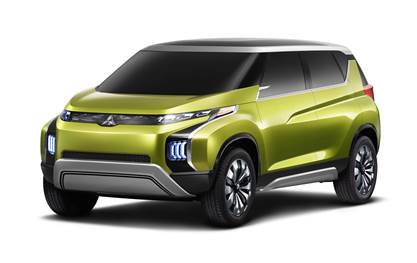 Unveiled in November 2013 at the 43rd Tokyo Motor Show, Concept AR (for “Active Runabout”) is a next-generation compact MPV which combines SUV sportiness with MPV roominess.
Unveiled in November 2013 at the 43rd Tokyo Motor Show, Concept AR (for “Active Runabout”) is a next-generation compact MPV which combines SUV sportiness with MPV roominess.
Stretched over 4350 mm, Concept AR’s clean-cut lines make for an unusual proposition in the marketplace, lifting up the spirit of essentially functional MPVs with its commanding driving position, powerful front design, high wraparound grille / headlamps, large skid plates and 3D-sculptured wheel arches.
At the same time, Concept AR renews the SUV genre with its long wheelbase / stubby nose proportions, sharpened by the upswept side character lines, the technical outline of its window line, the slim front grille with its bold diamond-cut pattern or the air outlets crafted into the rear pillars which serve to reduce aerodynamic drag.
Last but not least, like all three Tokyo Motor Show MMC concept cars[1], Concept AR features the brand’s new visual identity which will be gradually introduced with each new Mitsubishi Motors’ crossover and SUV over the coming years. Meant to symbolise the functionality and reassuring safety inherent to SUVs, this visual identity is made of vertical elements (either chromed or lighted) bracing the front end of the vehicle(s) either side of the grille.
Interior design – Soothing
Inside, Concept AR cleanly wraps occupants in simple and soft styling which does away with meaningless features, all meant to create a soothing ambiance.
Distinguished by soft and rounded lines the spacious cabin offers three alternative seating patterns giving generous seating room for six occupants, for four occupants with a sizeable luggage space or for a generous common space between the 2nd and 3rd row seats when they are turned to face each other.
Beyond the traditional MPV versatile seating arrangement, great care has also been given to providing enough individual personal space and also to the distance between fellow occupants – for instance, a passenger might pull out the tablet-type interface from its home slot in the side of the cabin and link up with the outside world through the internet or check out their emails and other personal information.
Within the compact dimensions of the body, the relatively long wheelbase provides a cabin that is open and airy. This is amplified by the gently bowed Crystal Lighted Roof from the centre of which indirect lighting provides passengers with soothing illumination.
The calming peacefulness of the cabin is further enhanced by gentle wind and other sounds emanating from slits in the side trim. With features such as easily detachable cup holders and a tablet-type interface, this forward-thinking interior design brings together enhanced convenience and comfort.
Mild Hybrid – Lightweight + Smart
 The front-wheel drive Concept AR is powered by a lightweight mild hybrid Belt-driven Starter and Generator system(BSG) featuring a 1.1-litre 3-cylinder direct-injection turbocharged MIVEC petrol engine mated to a low output BSG torque circuit with a 48V lithium-ion battery.
The front-wheel drive Concept AR is powered by a lightweight mild hybrid Belt-driven Starter and Generator system(BSG) featuring a 1.1-litre 3-cylinder direct-injection turbocharged MIVEC petrol engine mated to a low output BSG torque circuit with a 48V lithium-ion battery.
The rear-mounted battery and converter work in cooperation to provide instant engine restarting after an idle-stop and to deliver gutsy torque assist under acceleration.
BSG is used to recover kinetic energy during regenerative braking to further improve fuel economy and CO2emissions and to offer a pleasant experience to all on-board.
During its development, Concept AR has also been subject to an exhaustive weight reduction program targeting the engine and the hybrid system overall together with the more extensive use of high-tensile strength steel panels as already implemented in Mitsubishi Motors’ latest products (Outlander / Mirage) and also, of lightweight structural materials in strategic locations. This significant weight reduction also contributes significantly to the dynamic and environmental performances of the vehicle.
This weight reduction was extended to the no-frill design of the dashboard, seats and even the choice of upholstery trim. The result is a significant reduction in fuel consumption together with a smoother and more comfortable ride.
Active Safety Technology – Protect
Concept AR is equipped with Mitsubishi Motors’ advanced active safety connected technologies relying on next-generation information systems
These systems work in cooperation to anticipate and alert the driver about dangerous situations as well as to activate safety functions rapidly and accurately. Their main functions include:
- Rearward Blind Spot Vehicle Warning System[2]
- Driving Safety Support System[3]
- Auto Hi-beam
- Unintentional Vehicle Move Off Control[4]
- Forward Collision Mitigation Braking (FCM)
- Lane Departure Warning (LDW)
- Adaptive Cruise Control (ACC)
Main specifications
| L x W x H | 4350 mm / 1780 mm / 1690 mm | ||
| Occupants: | 6 | ||
| Engine | Type: | 1.1-litre in-line 3-cyl. direct-injection turbocharged MIVEC |
|
| Max. output (net) | 100 kW | ||
| Fuel used: | Petrol | ||
| Belt-drivenStarter and Generator | Max. output | 10 kW (48V) | |
| Battery | Capacity V | 0.25 kWh (48V) | |
| Drivetrain: | 2WD (front-wheel drive) | ||
| Transmission | CVT with sub-transmission | ||
ENDS
[1] Concept XR-PHEV and Concept GC-PHEV are the two others, also displayed at the 2014 Geneva Motor Show
[2] This system helps avert collisions by alerting the driver to the presence of vehicles approaching from behind. This system also functions to detect and warn the driver of the presence of vehicles or other objects behind the driver’s own vehicle while backing in, such as when parking or leaving their garage.
[3] Promoted by the Japanese National Police Agency, this enhances safety by utilising communications with vehicles and road infrastructure to warn the driver of traffic signals ahead as well as the approach of pedestrians, vehicles and cyclists at junctions and urge the driver to slow down.
[4] When a front-mounted camera spots any objects immediately in front of the vehicle and sensors detect the mistaken use of the accelerator instead of the brake pedal, the system operates to limit engine power and restrain forward movement of the car. The system also urges the driver to be more careful.
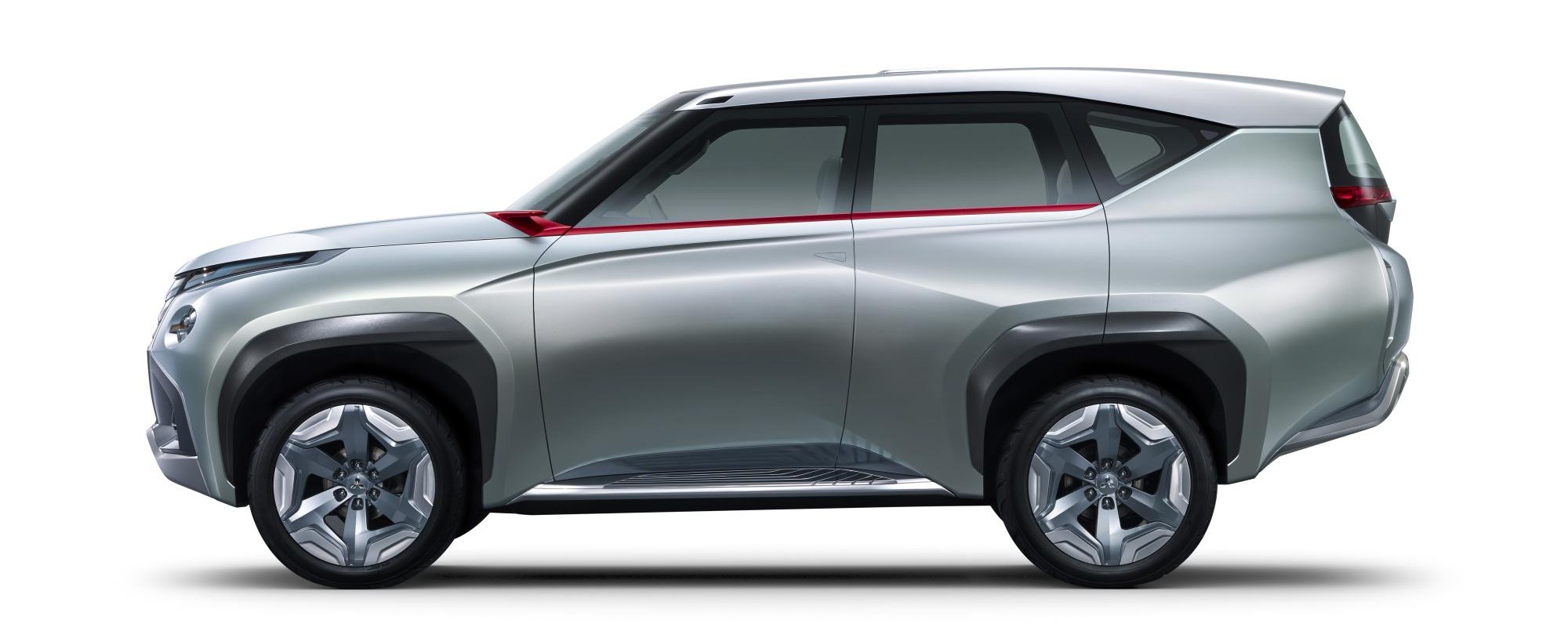
MITSUBISHI MOTORS AT THE 2014 GENEVA MOTOR SHOW CONCEPT GC-PHEV – OPEN SPACE
To be displayed for the first time in Europe during the 2014 Geneva Motor Show, Concept GC-PHEV blends nearly seven decades of Mitsubishi 4WD technology with the engineering fundamentals of the all-new low environmental impact Outlander PHEV – a new page in the full-size SUV textbook.
Next frontier SUV – Imagine
Unveiled in November 2013 at the 43rd Tokyo Motor Show, Concept GC-PHEV (for “Grand Cruiser”) is a next-generation full-time 4WD full-size SUV, fitted with an advanced plug-in hybrid electric (PHEV) powertrain.
True to a long line of 4WD Mitsubishi vehicles that started in 1936 with PX33[1], Concept GC-PHEV expresses MMC’s contemporary vision for a large, robust and powerful car able to pamper its passengers in utmost safety over all sorts of terrains (where legal), for work or leisure, with the lowest possible environmental impact.
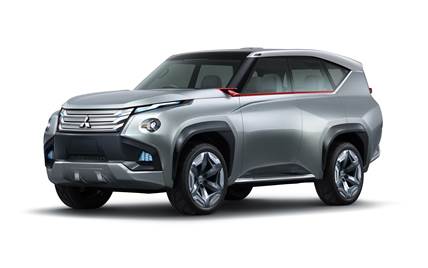 Carved solid design – Command
Carved solid design – Command
Concept GC-PHEV’s design is meant to express both a reassuring sense of safety and a welcoming and comfortable openness to the interior.
Exterior styling blends muscular volumes with sharp lines resulting in a sculpted 3D-shape which appears to have been carved out of a single block. With the day-time running lamps positioned high for maximum vehicle visibility, the headlamps located within the bumper, the high slatted grille and the large front skid plate, the front fascia is powerful, purposeful and stately.
At the rear, integrated seamlessly into the wide bumper, the large tailgate marries an appealingly fresh appearance with good functionality while rearward visibility is enhanced with the use of sub-windows.
The body design also utilises a combination of aerodynamic-enhancing features throughout, incl. variable front grille slats for better engine cooling, while the absence of B-pillars adds to the sense of openness, convenience and freedom provided by Concept GC-PHEV.
Like all three Tokyo Motor Show MMC concept cars[2], Concept GC-PHEV features the brand’s new visual identity which will be gradually introduced with each new Mitsubishi Motors crossover and SUV over the coming years. Meant to symbolise the functionality and reassuring safety inherent to SUVs, this visual identity is made of vertical elements (either chromed or lighted) bracing the front end of the vehicle(s) either side of the grille.
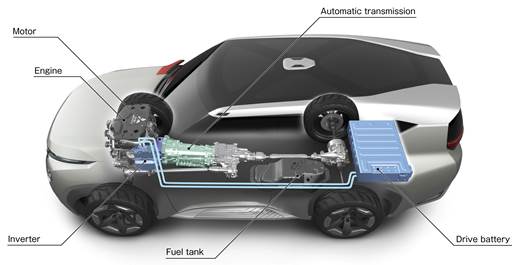 All-terrain[3] PHEV – Power
All-terrain[3] PHEV – Power
Concept GC-PHEV features a plug-in hybrid electric system to provide the level of powerful, solid and satisfying driving experience expected from a full-size SUV, yet with the lowest possible environmental impact taken for granted today.
Applying Outlander PHEV’s engineering fundamentals to a much bigger, more powerful, all-terrain (where legal) high-end full-size SUV, Concept GC-PHEV develops plug-in hybrid electric powertrain technology even further.
In this case, the PHEV powertrain is made of a 3.0-litre V6 super-charged MIVEC petrol engine, a clutch, an 8-speed automatic transmission, a high-output electric motor and a high-capacity battery, the latter installed under the rear cargo floor for better front/rear weight distribution.
As for Outlander PHEV, this new PHEV system automatically switches automatically between pure EV Mode and Hybrid Mode(s) depending on driving conditions, remaining battery charge and other factors.
In the case of Concept GC-PHEV, Mitsubishi Motors engineers took the PHEV concept even further through:
- Integration of an 8-speed automatic gearbox: integral to the PHEV system. In EV Mode, it is intended to maximise motor output efficiency at all vehicle speeds (within legal limits). In Hybrid Mode(s), it extracts power from the engine while the high-output motor kicks in to provide additional power as and when required.
- Move from two electric motors (front and rear) as fitted to Outlander PHEV to one single motor, saving on weight and friction losses.
Delivering punchy performance with comfortable reserves of power, the PHEV system makes for a solid and satisfying driving experience and helps Concept GC-PHEV take poor road surfaces or pulling a caravan or trailer easily in its stride. It also delivers the excellent response and smooth acceleration and luxury-car levels of quietness inherent to the PHEV system.
Concept GC-PHEV PHEV’s high-capacity battery can be used as an external power source. The 100V AC on-board socket can output up to 1500 watts of electrical energy, ideal for powering equipment when camping or enjoying other outdoor pursuits as well as providing an emergency power source for domestic appliances. The system can supply the equivalent of a day’s power consumption in an average household from the battery alone and up to a maximum of up to 13 days when the engine is used to fill the battery.
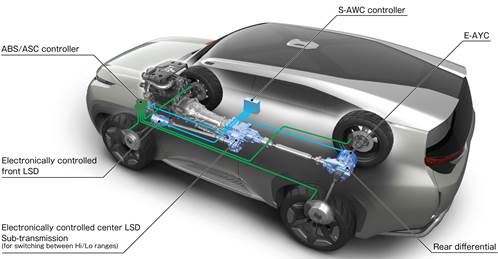 Super-All Wheel Control – Drive
Super-All Wheel Control – Drive
Originally introduced with Lancer Evolution and then extended to Outlander PHEV, Mitsubishi Motors’ advanced Super-All Wheel Control (S-AWC) integrated vehicle dynamics control system – working mainly by controlling torque distribution to and braking effort at each wheel – has been optimised for Concept GC-PHEV to provide handling that accurately reflects driver intent together with rock-steady vehicle stability.
In this new application, S-AWC is based on a full-time 4WD system including a rear differential + an Electronically-controlled Limited Slip Differential (LSD) at the front + another Electronically-controlled Limited Slip Differential in the centre + an Electric-Active Yaw Control (E-AYC) unit at the rear. The latter uses torque from the electric motor to precisely control torque distribution to each rear wheel, providing excellent vehicle stability.
Furthermore, low range – to be used off road (where legal) – is obtained through a centrally-mounted Sub-Transmission unit, acting as transfer case. According to road surface conditions and the selected traction mode, S-AWC works in cooperation with the PHEV system to assist the driver in following their chosen line through corners as well as realising remarkable all-terrain (where legal) performance.
Connected Car Technology- Inform
Concept GC-PHEV is equipped with advanced Mitsubishi Motors’ “connected car” technology which utilises next-generation information systems.
This technology is set to bring significant changes to the time we spend in our cars. Linked to a vehicle information network, the connected car system uploads vehicle status information on a real-time basis and links it with traffic in the vicinity, traffic signal and other information to advise the driver on how to drive their car more economically.
The system also provides a Failure and Malfunction Early-detection System, which urges the driver to seek repairs or service, as well as an Accident Damage Prediction Reporting function including link to the emergency and safety services.
Augmented Reality (AR) Windshield – Foresee
Looking at further possibilities for connected car technology, Concept GC-PHEV is fitted with novel interface systems. These include the AR Windshield, which utilises augmented reality technology, as well as the Tactical Table large touch-operated display located in the centre of the cabin.
The AR Windshield employs Augmented Reality technology to display information necessary to the driver on the windscreen while the vehicle is on the move. By projecting information into their forward field of view, the AR Windshield allows the driver to ascertain their vehicle status without taking their eyes from the road. Information projected onto the windshield includes: Sat-Nav-linked Route Guidance; Active safety system-linked Distance to Vehicle in Front; and Lane Departure Warning.
The AR Windshield also presents Caution Tracking information which uses vehicle-to-vehicle and pedestrian-to-vehicle communications to give the driver guidance on and display alerts about vehicles or pedestrians approaching from blind spots at junctions.
Tactical Table – Gather, Create & Share
Located in the centre of the cabin, the touch-screen Tactical Table is a new kind of tool that uses connected car technology to push the boundaries of occupant fun and pleasure in unknown ways.
No one-way street – where information is only received – the Tactical Table generates a new style of motoring life where occupants can use their smart phones to “gather” information on their trip, “Create” an original map or trip plan as well as “Share” that information with others using on board communicators.
Active Safety Technology – Protect
Concept GC-PHEV features MMC’s next generation electronic “active” safety system in cooperation with connected car technology to realise an enhanced level of vehicle and occupant protection through forward, rear blind-spot assistance.
In the case of Concept GC-PHEV, the system includes:
- Cooperative Adaptive Cruise Control, with Lane Keep Assist which provides forward visual assistance on motorways and main roads by sharing acceleration/deceleration information on the vehicle in front using vehicle-to-vehicle and vehicle-to-infrastructure communications to realise more accurate distance-to-vehicle-in-front control, while also encouraging more economical operation of the vehicle and helping to relieve traffic congestion.
- Lane Keep Assist function provides appropriate handling support to prevent the driver from drifting out of their lane due to fatigue or inattention. The system includes a Traffic Sign Recognition System which uses an on-board camera to recognise and inform the driver about road signs, and also activates the engine speed limiter in an emergency.
- Adaptive Headlamps use the on-board camera to detect the position of oncoming vehicles or pedestrians while the headlamps are on high beam and blank off that area of illumination to prevent dazzling.
For all-directional driver assistance, the electronic “active” safety system employs eight infrared cameras – two at the top of the windscreen, one in each A pillar, one behind each rear door window, and one on either side at the top of the tailgate – to scan the periphery of the vehicle. High definition image processing enables the system to instantly and accurately detect any risk factors close to the vehicle. The system also uses a Night Eye Multi-around Monitor to rapidly alert and warn the driver of the approach of any obstacles or other vehicles.
The Mitsubishi electronic “active” safety system also incorporates many other functions including:
- Pedestrian Collision Mitigating Auto-braking: This radar- and camera-based system detects pedestrians ahead of the vehicle at night and in other situations where they are difficult to spot and alerts the driver to their presence. The system will also automatically apply the brakes to avoid a collision or to mitigate injury.
- Rearward Blind Spot Vehicle Warning: This system helps avert collisions by alerting the driver to the presence of vehicles approaching from behind. This system also functions to detect and warn the driver of the presence of vehicles or other objects behind the driver’s own vehicle while reversing, such as when parking or leaving their garage.
- Driving Safety Support System: promoted by the Japanese National Police Agency, it enhances safety by utilising communications with vehicles and road infrastructure to warn the driver of traffic signals ahead as well as the approach of pedestrians, vehicles and cyclists at junctions and urge the driver to slow down.
- Unintentional Vehicle Move Off Control:When a front-mounted camera spots any objects immediately in front of the vehicle and sensors detect the mistaken use of the accelerator instead of the brake pedal, the system operates to limit engine power and restrain forward movement of the car. The system also urges the driver to be more careful.
- Driver Monitor: Uses an infrared camera installed in front of the driver as well as sensors in the steering system and in the driver seat to monitor eye blinking and changes in posture to assess the driver’s level of alertness. If the system detects abnormalities in driving behavior, such as when the car starts to wander on the road, it instantly alerts the driver and urges taking a rest. It also alerts the driver when it determines their concentration has dropped or when they glance away from the road in front.
Main specifications
| L x W x H | 4930 / 1940 / 1980 mm | ||
| Occupants: | 4 | ||
| Hybrid fuel efficiency | > 15.0 (under the Japanese JC08 test cycle) | ||
| Plug-in Cruising range | > 40 km | ||
| Engine | Type: | 3.0-litre V6 supercharged MIVEC |
|
| Max output (net) |
250 kW | ||
| Fuel used: | Petrol | ||
| Motor | Max. Output: | 70 kW | |
| Battery | Capacity: | 12 kWh | |
| Drivetrain: | Full-time 4WD | ||
| Transmission | 8-speed automatic gearbox | ||
ENDS
[1] PX33 was a landmark both for Mitsubishi and for the automobile industry as it was the first Japanese 4WD passenger car. Four research units of this torpedo were built then.
[2]Concept XR-PHEV and Concept AR are the two others, also displayed at the 2014 Geneva Motor Show
[3]Where legal
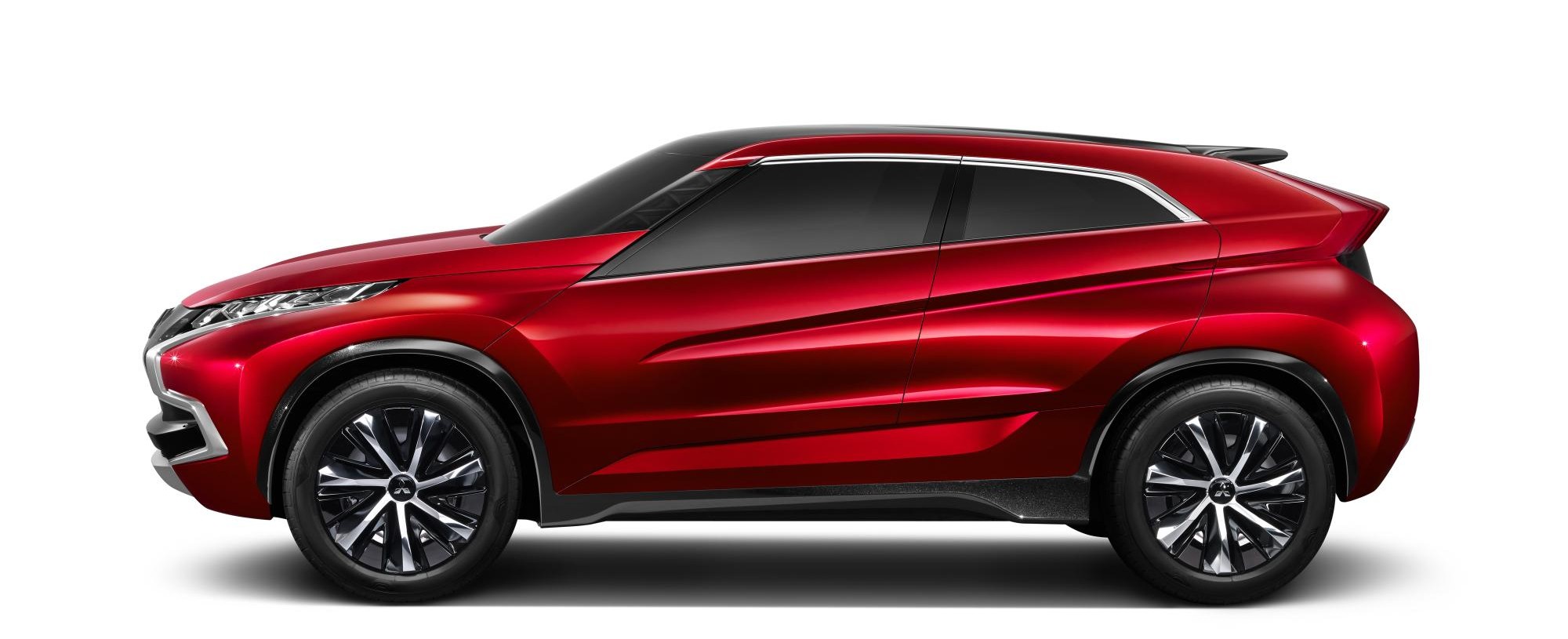
MITSUBISHI MOTORS AT THE 2014 GENEVA MOTOR SHOW CONCEPT XR-PHEV – AGILE
To be displayed for the first time in Europe during the 2014 Geneva Motor Show, Concept XR-PHEV brings plug-in hybrid electric technology at the heart of the European market – a smart combination of engineering fluency, low environmental impact, dynamic agility and sharp coupé-like design.
PHEV development – Fast forward
Unveiled in November 2013 at the 43rd Tokyo Motor Show, Concept XR-PHEV (“X (cross) over Runner”) is a next-generation C-Segment crossover using Mitsubishi Motors’ plug-in hybrid electric (PHEV) powertrain in a novel front-wheel drive layout and blending SUV functionality with sport coupe design – a sharp expression of (low impact) driving pleasure.
Coupe-like design – Athletic
The key concept behind the development of the Concept XR-PHEV’s exterior design was a track athlete’s form. The dynamic energy of a sprinter exploding out of the blocks and still bent at the waist is referenced in the wedge-inspired character line and in the forward-leaning silhouette. The muscular, taut wings embrace the over-size tyres and, while having a low ground clearance, the rake, or slightly raised rear riding height, gives a tantalising foretaste of the car’s agile and all-round performance.
Centering on the 3-Diamond logo, the front fascia projects the forceful dynamic energy and functionality of a SUV together with an imposing road presence. The grille frame starts under the adaptive headlamps and flexibly accommodates movements in the body.
Concept XR-PHEV uses solar panels built into the roof which serve to charge the auxiliary equipment battery and also has a variable angle spoiler on the trailing edge of the roof which can be adjusted for different driving conditions.
Like all three Tokyo Motor Show MMC concept cars[1], Concept XR-PHEV features the brand’s new visual identity which will be gradually introduced with each new Mitsubishi Motors crossover and SUV over the coming years. Meant to symbolise the functionality and reassuring safety inherent to SUVs, this visual identity is made of vertical elements (either chromed or lighted) bracing the front end of the vehicle(s) either side of the grille.
Stimulating interior – Focused
Concept XR-PHEV features a driver-oriented cockpit designed to stimulate sporty driving.
The bucket-type driver’s seat provides firm location and support to allow drivers to operate vehicles with assurance and precision. The seat is upholstered in red coordinated with exterior and interior accent colours to give the driver their very own “director’s chair” and is quite distinct from the other three seats.
The speedometer, tachometer and other information displays are designed to allow the driver to instantly spot changes and to concentrate on operating their vehicle.
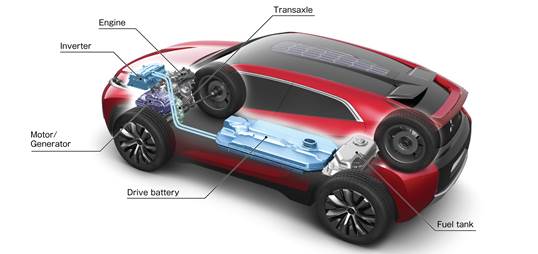 Front-wheel drive PHEV – C-Segment
Front-wheel drive PHEV – C-Segment
Concept XR-PHEV uses a lightweight and high-efficiency front-wheel drive PHEV system derived from the well-proven system used to power the Outlander PHEV.
In this new configuration, Mitsubishi Motors’ PHEV powertrain is made of a 1.1-litre in-line 3-cylinder MIVEC turbocharged petrol engine; a single (instead of two for Outlander PHEV) lightweight, compact and high-efficiency motor with a high-boost converter at the front; and a high-capacity battery under the floor. The boost converter increases motor and generator output and efficiency.
Opting for a front-wheel drive PHEV system with no motor at the rear reduces weight as well as friction losses and returns improvements in fuel and electricity economy, much appreciated by customers of more accessible smaller C-Segment vehicles such as the 4.37 m long Concept XR-PHEV.
From the default mode of pure EV, Concept XR PHEV powertrain automatically selects from two additional drive modes – Series Hybrid and Parallel Hybrid – the one best-suited to driving conditions and remaining battery charge, just like with Outlander PHEV.
Along the same lines, 100% EV driving is possible through use of Battery Charge Mode or Battery Save Mode.
Concept XR-PHEV is also fitted with 100V AC on board sockets capable of giving an external supply of up to 1500W of power. The system can supply enough electricity to power domestic appliances for a full day from the drive battery alone and up to a maximum of 10 days when the engine is used to fill the battery.
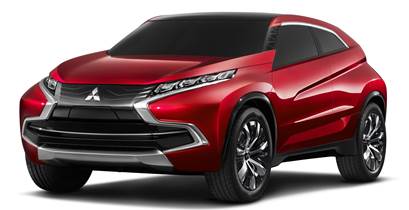 Active Safety Technology – Protect
Active Safety Technology – Protect
Concept XR-PHEV has been developed to deliver sure-footed dynamics and agile performance for the sake of driving pleasure.
This includes reassuring levels of safety brought – amongst others – by MMC’s electronic “active” safety system to help the driver to avoid accidents and collisions, as well as advanced connected car information communications technology.
These two systems work in cooperation to anticipate and alert the driver to dangerous situations as well as to activate safety functions rapidly and accurately and thereby support safer driving. Their main functions include:
- Pedestrian Collision Mitigating Auto-braking
- Rearward Blind Spot Vehicle Warning System[2]
- Driving Safety Support System[3]
- Auto Hi-beam
- Unintentional Vehicle Move Off Control[4]
- Forward Collision Mitigation Braking (FCM)
- Lane Departure Warning (LDW)
- Adaptive Cruise Control (ACC)
Main specifications
| L x W x H | 4370 / 1870 / 1570 mm | ||
| Occupants: | 4 | ||
| Hybrid fuel efficiency: | > 28 km/l | ||
| Plug-in cruising range: | > 85 km | ||
| Engine | Type: | 1.1-litre in-line 3-cyl. direct-injection turbocharged MIVEC |
|
| Max output (net): |
100 kW | ||
| Fuel used: | Petrol | ||
| Motor | Max. output: | 120 kW | |
| Battery | Capacity: | 14.0 kWh | |
| Drivetrain: | 2WD | ||
| Transmission | Front wheel drive | ||
ENDS
[1]Concept GC-PHEV and Concept AR are the two others, also displayed at the 2014 Geneva Motor Show
[2]This system helps avert collisions by alerting the driver to the presence of vehicles approaching from behind. This system also functions to detect and warn the driver of the presence of vehicles or other objects behind the driver’s own vehicle while backing in, such as when parking or leaving their garage.
[3]Promoted by the Japanese National Police Agency, this enhances safety by utilising communications with vehicles and road infrastructure to warn the driver of traffic signals ahead as well as the approach of pedestrians, vehicles and cyclists at junctions and urge the driver to slow down.
[4]When a front-mounted camera spots any objects immediately in front of the vehicle and sensors detect the mistaken use of the accelerator instead of the brake pedal, the system operates to limit engine power and restrain forward movement of the car. The system also urges the driver to be more careful.

